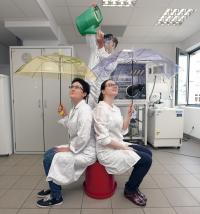Exceptional ZnO Quantum Dots the World Was Waiting For
For many years chemists struggled with creating a simple and efficient method of manufacturing stable quantum dots susceptible to functionalization while retaining their unique luminescent properties. This objective was achieved by the team headed by prof. Janusz Lewiński from the Faculty of Chemistry at the Warsaw University of Technology.
“Everything began 10 years ago, when one of my doctoral students and I were guests at a laboratory that manufactured nanomaterials, and we saw how simple it was”, prof. Janusz Lewiński reminisces. “I asked then, why aren’t we doing it in our laboratory?”
One Dot Is Not Quite Like Other Dots
“Quantum dots are nanocrystals (around 2-10 nm in size), approximately spherical, made of a semiconductor material”, says Małgorzata Wolska-Pietkiewicz, doctoral student of prof. Lewiński. “Optical properties of quantum dots mainly depend on their size, i.e. the smaller the nanoparticle, the more its emitted colour shifts towards blue, while bigger nanoparticles emit colours shifted more towards red”.
Why quantum dots are so intriguing to the world of science? They are made of semiconductor materials and, due to their size, they demonstrate a variety of interesting properties typical of quantum objects. For example, they absorb and emit radiation with exactly specified energy. Unique optical properties of quantum dots find more and more applications. Until recently, the idea of a quantum dot was popular only amongst scientists; nowadays LCD TV and monitor manufacturers are introducing “glowing” quantum dots technologies on the market.
Where Is the Catch?
In order for quantum dots to have desired properties, their inorganic core must be shielded by a properly designed shell made of organic compounds. One of the best methods of efficient modification for such “nanocapsules” are simple and efficient “click” reactions, which allow easy joining of various organic compounds and the organic shell of a quantum dot. The most efficient “click” reactions are catalysed by copper(I) compounds. Unfortunately, until now the presence of copper ions has caused ZnO quantum dots manufactured using traditional methods to lose their unique luminescent properties.
Therefore, prof. Lewiński’s team’s key to success was to prepare a new, original, metal-organic method of synthesizing ZnO quantum dots with exceptionally tight organic shells, which effectively protect the core from direct contact with copper ions. ZnO quantum dots manufactured in this way retain their original luminescent properties after “click” functionalization. It is a substantial step ahead compared to the commonly used method of synthesizing ZnO quantum dots, i.e. the sol-gel method using inorganic precursors. Quantum dots obtained using the sol-gel method are coated with non-tight protective shell, which results in direct contact of copper ions with ZnO surface and complete reduction of luminescence.
Unique Method
How to obtain glowing ZnO quantum dots? “A properly designed zinc-organic precursor is subjected to controlled exposure to atmospheric air, which produces zinc oxide nanoparticles”, Małgorzata Wolska-Pietkiewicz explains. “We can control the size of obtained nanoparticles by varying time and temperature”.
The method prepared by prof. Lewiński’s team is already patented.
It’s difficult to maintain consistency using the classic sol-gel method, where the nanocrystal manufacturing process is kinetically controlled. The method used by the WUT scientists is controlled thermodynamically and thus facilitates obtaining higher-quality quantum dots through a more consistent process.
The scientists have also demonstrated that they can “program” quantum dots so that they create colloidal systems, stable in water environments, and which are almost completely non-toxic to biological materials. It will enable the future use of zinc oxide quantum dots as e.g. fluorescent nanomarkers for biological or medical diagnostic applications. Such nanoobjects can be used to mark both individual cells and entire tissues. Moreover, exceptional properties of quantum dots enable long-term monitoring of marked elements, e.g. drug administration routes.
Chemistry Without Borders
The road to such an exceptional discovery is long and bumpy. It’s not a result of an epiphany, but rather of long-term basic studies. “We try to deeply understand individual stages of chemical transformations; it helps us in designing rational reaction systems. We cultivate a ‘chemistry without borders’”, prof. Lewiński laughs. “We don’t perceive chemistry through narrow specializations. For us, chemistry is a branch of science dealing in breaking and forming of chemical bonds in a highly controlled manner, so as to make molecules or materials behave in a desired way”.
Post Scriptum
Currently the most common type of quantum dot in use includes heavy metals in its structure, which substantially restricts its use for e.g. medical purposes. Scientists from the Faculty of Chemistry at the Warsaw University of Technology and the Institute of Physical Chemistry at the Polish Academy of Sciences had to tackle this challenge.
“We have designed a new method of synthesizing ZnO quantum dots, and preliminary research shows that our dots have unique properties”, prof. Lewiński emphasizes. “In addition to almost identical shape and size, they do not aggregate and they’re coated with a homogeneous, tight organic shell, which is resistant in respect to both chemical and biological environments. They also demonstrate exceptionally long luminescence lifetimes (hundreds of microseconds), which is hundreds of millions times longer than those of classic quantum dots obtained from inorganic precursors. The exceptional quality of obtained nanomaterials opens new possibilities for their various uses”.
In order to further develop the ZnO quantum dot manufacturing technology, the team plans to establish its own research and development centre. Intensive works are underway for obtaining funding from both government projects and private investors.
Monika Bukowska
Office for Promotion and Information








